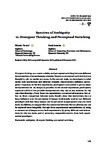Spectres of ambiguity in divergent thinking and perceptual switching
| dc.contributor.author | Taranu, M | en |
| dc.contributor.author | Loesche, F | en |
| dc.date.accessioned | 2018-10-30T10:18:25Z | |
| dc.date.available | 2018-10-30T10:18:25Z | |
| dc.date.issued | 2017-01-01 | en |
| dc.identifier.uri | http://hdl.handle.net/10026.1/12682 | |
| dc.description.abstract |
Divergent thinking as a creative ability and perceptual switching between different interpretations of an unchanging stimulus (known as perceptual multistability) are thought to rely on similar processes. In the current study, we investigate to what extent task instructions and inherent stimulus characteristics influence participants' responses. In the first experiment, participants were asked to give as many interpretations for six images as possible. In the second experiment, participants reported which of two possible interpretations they saw at any moment for the same line drawings. From these two experiments, we extracted measures that allow us direct comparison between tasks. Results show that instructions have a large influence over the perception of images traditionally used in two different paradigms and that these images can be perceived in appropriate ways for both tasks. In addition, we suggest that the connection between the two phenomena can be explored interchangeably through three experimental manipulations: a) using a common set of images across both experiments, b) giving different task instructions for the two tasks, and c) extracting comparable metrics from both experimental paradigms. | en |
| dc.format.extent | 121 - 133 | en |
| dc.language.iso | en | en |
| dc.rights | Attribution-ShareAlike 4.0 International | en |
| dc.rights | Attribution-ShareAlike 4.0 International | en |
| dc.rights | Attribution-ShareAlike 4.0 International | en |
| dc.rights | Attribution-ShareAlike 4.0 International | en |
| dc.rights | Attribution-ShareAlike 4.0 International | en |
| dc.rights | Attribution-ShareAlike 4.0 International | en |
| dc.rights | Attribution-ShareAlike 4.0 International | en |
| dc.rights | Attribution-ShareAlike 4.0 International | en |
| dc.rights.uri | http://creativecommons.org/licenses/by-sa/4.0/ | en |
| dc.rights.uri | http://creativecommons.org/licenses/by-sa/4.0/ | en |
| dc.rights.uri | http://creativecommons.org/licenses/by-sa/4.0/ | en |
| dc.rights.uri | http://creativecommons.org/licenses/by-sa/4.0/ | en |
| dc.rights.uri | http://creativecommons.org/licenses/by-sa/4.0/ | en |
| dc.rights.uri | http://creativecommons.org/licenses/by-sa/4.0/ | en |
| dc.rights.uri | http://creativecommons.org/licenses/by-sa/4.0/ | en |
| dc.rights.uri | http://creativecommons.org/licenses/by-sa/4.0/ | en |
| dc.title | Spectres of ambiguity in divergent thinking and perceptual switching | en |
| dc.type | Journal Article | |
| plymouth.issue | Specialissue | en |
| plymouth.volume | 8 | en |
| plymouth.publication-status | Published | en |
| plymouth.journal | Avant | en |
| dc.identifier.doi | 10.26913/80s02017.0111.0012 | en |
| plymouth.organisational-group | /Plymouth | |
| plymouth.organisational-group | /Plymouth/Faculty of Science and Engineering | |
| dc.identifier.eissn | 2082-6710 | en |
| dc.rights.embargoperiod | Not known | en |
| rioxxterms.versionofrecord | 10.26913/80s02017.0111.0012 | en |
| rioxxterms.licenseref.uri | http://creativecommons.org/licenses/by-sa/4.0/ | en |
| rioxxterms.type | Journal Article/Review | en |



